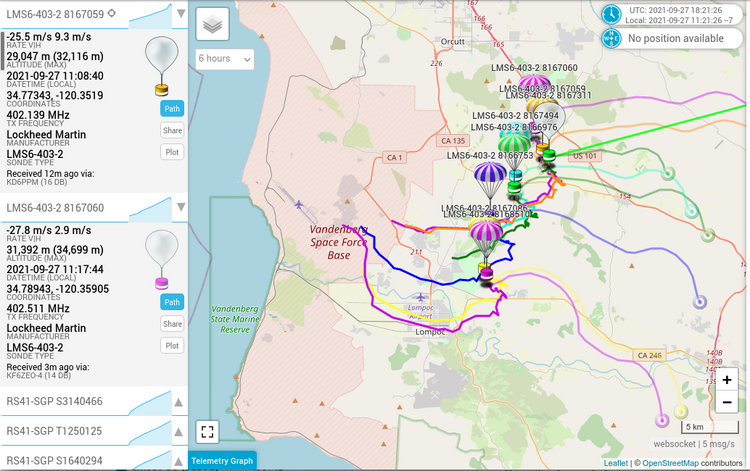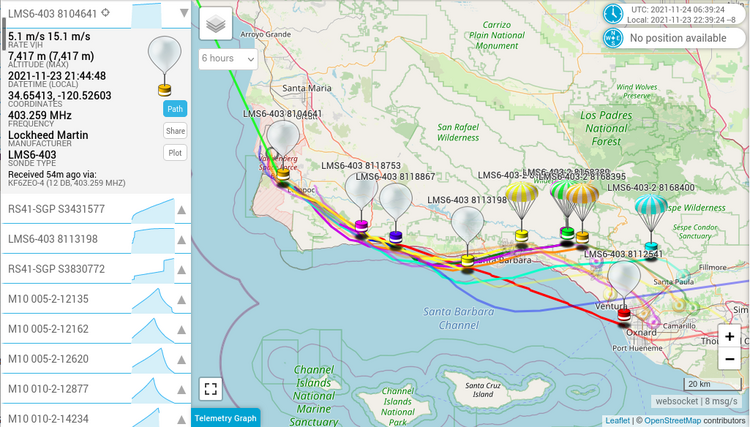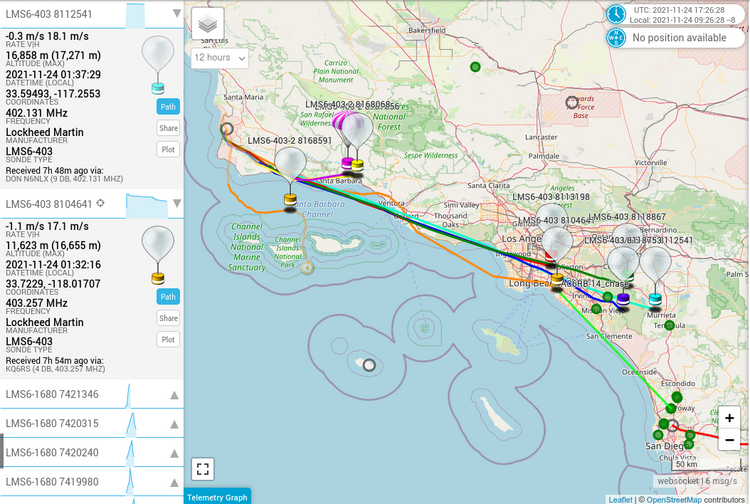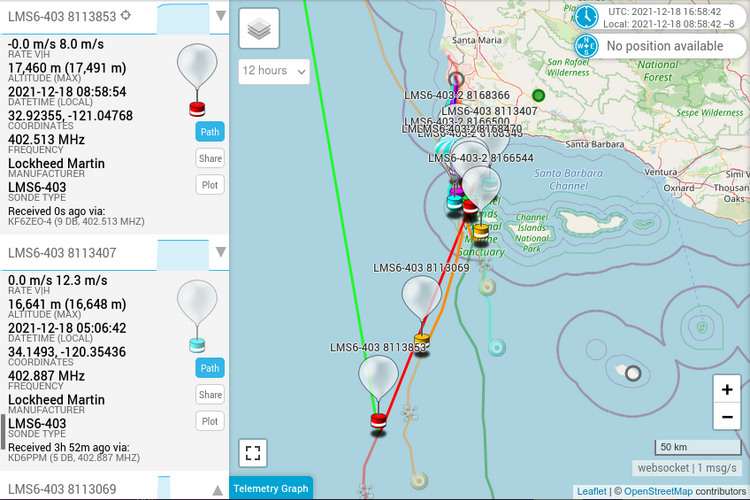Just after setting up a remote receiving station in the hills above Santa Cruz for tracking radiosondes launched from Monterey Bay, I started noticing some weird stuff with the station. The station would detect a LMS6-403 radiosonde, but was unable to actually decode anything. The "jamming" signal was always on the same frequency of 400.259 MHz, and occurred daily around noon and midnight UTC.
I speculated that it might be radiosondes from Vandenberg Space Force Base, approximately 300 km (~180 miles) south of the receiver along the coast of California. Although it would be cool to receive those radiosondes, the purpose of this station was to track the Monterey Bay radiosondes, so I put that frequency on the blacklist and turned my attention to the task at hand.
New LMS6-403 Radiosonde Version
A few days later, my curiosity got the better of me, and I started to investigate these signals. Over the course of four days, I did decode a single packet each from two radiosondes. Based on the location, these definitely were from Vandenberg, but the signal must be different than the regular LMS6-403 type radiosondes. I started asking questions on the radiosonde_auto_rx email list, and recorded some raw IQ spectrum files.
Based on the spectrum IQ recordings, rs1729 immediately identified a slightly different header from the standard LMS6-403 radiosondes. Everything about the packet was the same except for a single byte in the header. Maybe this new header indicates a completely different hardware version, or just something custom for Vandenberg, or maybe it means nothing at all. Two fixes were pushed to the testing branch, and made it into the 1.5.6 version.
This new radiosonde version (launched only at Vandenberg as far as I can tell) was labeled "LMS6-403-2" on Sondehub to differentiate it from the regular "LMS6-403" radiosondes. The only difference in flight profile with these new radiosondes is that they stop transmitting just after max elevation. While this is better from a frequency reuse perspective, it makes it almost impossible to recover one of these new models. Also, their serial numbers start with 816 instead of 811.
Rocket Launches
In addition to the regular noon UTC radiosonde launches, Vandenberg releases many radiosondes just before a rocket launch. This is to make sure the upper atmosphere winds aren't too strong that they could possibly damage a rocket or blow it off course.
As soon as the decoding bug was squashed, there were a few rocket launches from Vandenberg. On September 12th, 2021, there was an MDA test (pdf), and the next day a SpaceX Starlink (pdf) launch occurred.
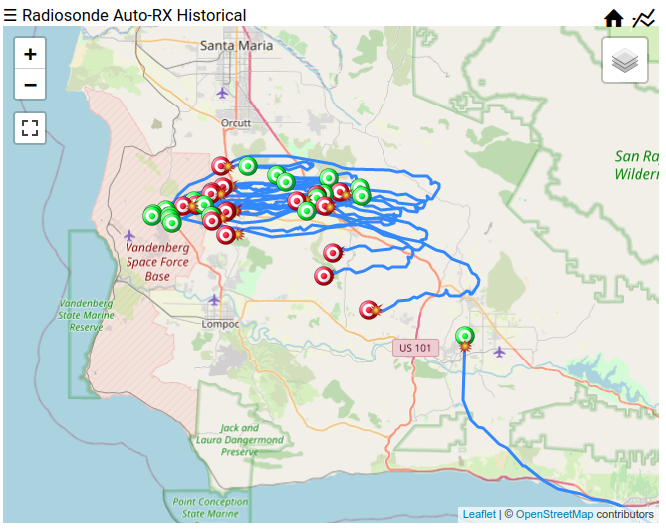
On September 27th, 2021, an Atlas V blasted off from Vandenberg, carrying Landsat-9 (pdf).
Comparing the radiosondes I was receiving on my Santa Cruz station, and the ones other people were receiving on Sondehub during the launch, I realized that I wasn't receiving some of the radiosondes. For the next launch, I wanted to determine how many radiosondes were released during a typical rocket launch, and determine their launch cadence.
DART Launch
Luckily I didn't need to wait long. Almost a month later, just before Thanksgiving on November 23rd, 2021, NASA launched the Double Asteroid Redirection Test (DART) satellite from Vandenberg. Since I had only a single RTL-SDR receiver at the Santa Cruz station, I had to get a bit creative with more than one radiosonde in the air. I used the "never_scan" feature to blacklist sondes that I already knew were in the air, or ones that were being received by other stations nearby and being reported to Sondehub.
Using the packets I received, and a few from Anthony KD6PPM, I calculated the launch times for the radiosondes. The rocket lifted off (pdf) at 0621 UTC (10:21pm local time) on a Falcon 9.
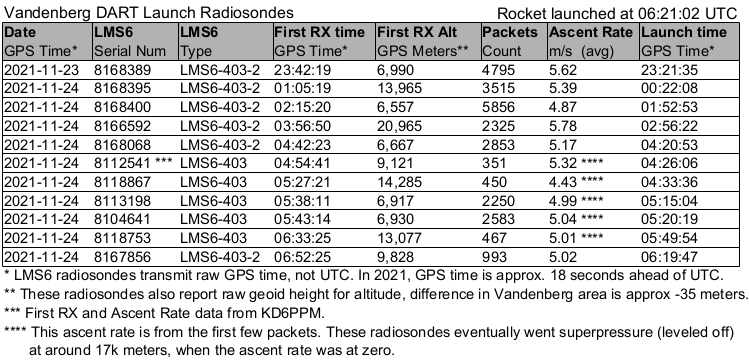
There didn't seem to be a regular cadence of radiosonde launches before a rocket launch. Maybe, if you squint hard enough, every thirty minutes at 20 and 50 minutes past the hour? But I would be hard pressed to find any signal in that noise.
I calculated that the minimum time between radiosonde launches was about 5 minutes, which probably indicates that multiple people are working at the weather station. During other launches I have witnessed, it takes 30 min or so to turn on the radiosonde, verify electronics calibration and transmission on the right frequency, fill the balloon, tie everything together, and release it. As far as I know, there is no autolauncher for the LMS6-403 radiosondes, so this would be an entirely manual process.
One possible explanation for the very short period between the three radiosonde launches is that this wind data is mission critical. If the entire launch (~$70 million) depends on this wind data (a ~$150 device), then launch a few just to be triple sure. The flurry of launches happened around 0420 UTC, and the launch was scheduled for two hours later.
If the range didn't need redundant radiosondes for wind data, another possible explanation is training. Maybe there were a few trainees learning .
One very interesting aspect of this DART launch was they released both the old LMS6-403 and new LMS6-403-2 type radiosondes. The six newer LMS6-403-2 radiosondes followed the typical flight path, but the five older LMS6-403 radiosondes all went superpressure and leveled off at around 17k meters. I thought that getting a latex balloon to superpressure was pretty hard, but I guess as long as the weight of the payload is equal to the lift of the gas, any balloon can become a floater.
Here is a table of the five superpressure balloons.

Why did these five radiosondes go superpressure and level off? I'm pretty sure this was unintentional, as the whole point of radiosondes is to get an accurate measurement of the upper atmosphere winds from the surface up to around 30k meters (100k feet). This is very important when launching rockets, as you don't want them to literally be blown off course if the jetstream is super strong that day. But maybe the rocket range only cares about the winds up to 10k or 15k meters, when the rocket is still traveling relatively slowly and the air is much thicker.
Phil Karn KA9Q speculated that it might have something to do with this new type of radiosonde that they are launching at Vandenberg. The five that went superpressure were the old type. Maybe the new radiosonde version is lighter than the old, but they used the same balloon size and neck lift for all of them? The older (heavier) radiosondes would not go as high as the newer (lighter) ones.
The superpressure balloons floated all the way to Irvine and Temecula in southern Los Angeles before they stopped transmitting. Note the flight trajectory difference between 8104641 (orange line) and the other balloons due to the much lower float altitude.
Another goal was to find out which frequencies were being used by these radiosondes. The LMS6-403 radiosondes are channelized every 375 kHz (pdf) starting at 400.250 MHz.
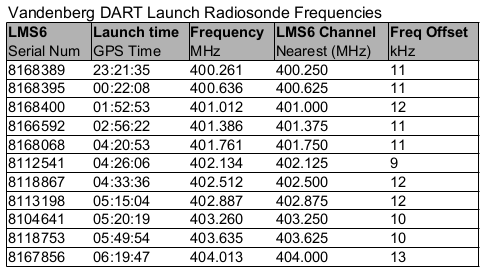
As one can see from the chart, the launch team started with the first channel and just went up from there. This is another indication that all of the radiosondes for this launch were received. Also, the frequency stability of these radiosondes is garbage.
Starlink 4-4 Launch
For another look at the radiosonde launch cadence, I observed the Starlink 4-4 launch from Vandenberg on December 18th, 2021. The Falcon 9 launch occurred at 12:41 UTC (4:41am local time). The winds were northerly for this launch, so many of the radiosonde receivers in the greater Los Angeles area didn't receive these.
Using the data from my receiver in Santa Cruz, and data uploaded by users to the Sondehub Database, I was able to calculate the launch times of some of the radiosondes.
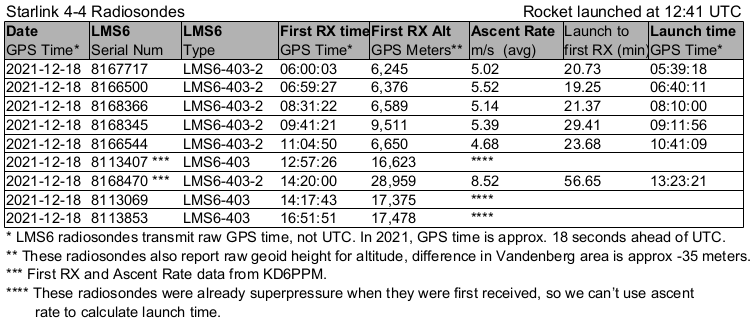
A total of eight radiosondes were released, and only three of them were the older type that went superpressure like the DART launch. Since this launch was very early in the morning local time, and I need my beauty sleep, I didn't get up to fiddle with my receiver. But two of the superpressure radiosondes were still floating far off the coast of Los Angeles when I woke up.
As one can see, again there really isn't a rhythm to the radiosonde launches. Looking at this launch, maybe they try to launch every hour and a half? But SpaceX might not care as much as NASA (or at all) about the winds, so the radiosonde data is not as crucial.
Another complicating factor in determining radiosonde release cadence is the different launch profiles for these two rockets. DART is headed on an Earth-escape trajectory into a heliocentric orbit, and therefore had a 1-second launch window. If the rocket and/or range is not ready at exactly the right time, the launch gets scrubbed and pushed to a following day.
In contrast, the launch window for the Starlink satellites is 2 hours. Starlink satellites are dropped off in a really low earth orbit of approximately 220 km. From there, the individual satellites thrust up to their final orbital altitude of ~550 km over the course of 30 days. Because of this long thrusting period, launch time is not crucial.
Conclusions
Vandenberg launches one radiosonde per day for the worldwide 12z radiosonde launch, but this data is not get fed into IGRA. Just before a rocket launch, Vandenberg releases many radiosondes to verify that upper atmosphere winds are within the rocket specifications.
The quantity and timing radiosondes is dependent on the launch provider and rocket orbit. More launches need to be observed before a cadence can be established.
Vandenberg launches a mix of old and new LMS6-403 radiosondes. The new LMS6-403-2 radiosondes stop transmitting just after the balloons burst, making recovery very difficult. Older LMS6-403 radiosondes go superpressure, floating for hours at around 17k meters until they stop transmitting, also making recovery very difficult.
